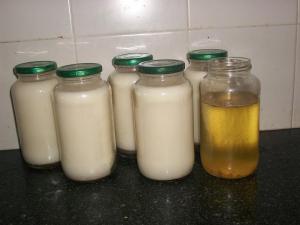Back in Feb. 2008, I wrote about tips for improving dental health. Many of these were from Rami Nagiel, before he wrote his book Cure Tooth Decay and became widely known in the traditional foods camp. My problem with Rami’s approach is that I don’t feel it’s doable on a budget and that it’s somewhat extreme. Rami’s approach is very absolute and doesn’t leave room for sometimes having grains or sweets. That’s very tough and not realistic for many people, even those dedicated to their children’s health. Since it’s based on high quality organic meats and vegetables, it’s also financially very daunting. It was thinking of this that made me feel hopeless yesterday, since I know we don’t have the funds for his protocol no matter how frugal I am and I also know that I can’t follow his guidelines 100%. What did encourage me was remembering about Dr. Ellie Phillips approach.
Dr. Ellie is a dentist who has worked with pediatric patients and others for many years. She’s written a book called Kiss Your Dentist Goodbye (I haven’t read it) and is now writing another book that will have information about the importance of diet to your teeth. I’m guessing this will be along the lines of the traditional foods approach. What is very encouraging about Dr. Ellie’s protocol for kids is that it’s so doable, and she doesn’t tell you to stop having all foods with phytic acids or anything else. Her approach is highly effective, affordable and doable.
The main issue with her protocol is consistency. For kids, she says that giving them xylitol five or six times a day after any food that isn’t dairy or vegetables will reset their mouth bacteria from acidic to alkaline. She recommends giving it in the form of xylitol water to drink. The recommended amount of daily xylitol intake for maximum dental benefits is between 6.5 – 10 grams a day; I think that’s about two teaspoons a day. No benefits have been demonstrated by giving more than that.
We were regularly brushing their teeth with xylitol for a while and then we got inconsistent and tapered off. In any case, it seems that drinking xylitol water is better and having it a few times a day rather than just at night before bed is much better. It’s also best to drink it throughout the day, ideally after each snack and meal to reset the ph balance of the mouth. Here’s a great article about mouth bacteria that is a must read to understand why people get cavities – if you’re someone who brushes and is careful about diet but you still have issues with cavities, this will explain what is going on and you’ll understand how important it is to systematically reset the ph balance and how xylitol works to benefit that. Reading this explanantion gave me a lot of hope since I already was convinced the issue was something about his acidic mouth fluids and I’m very optimistic based on her many years of experience that this can be the answer to helping ds5 reverse his dental caries issue.
Yesterday I started giving xylitol water to the younger boys (including Yirmiyahu even though he has no teeth, because he was in my lap when I was giving them drinks and he wanted some, too!) and they were very receptive. They loved it! So getting them to drink it won’t be the issue; the real concern is me keeping it in mind on a daily basis and making it into a family habit. Since there’s always so much going on this is a challenge for me but I’m going to do my best!
To make xylitol water, all you do is mix a couple of teaspoons of xylitol in hot water to dissolve the crystals, mix it and then add cooler water. This amount will be for one child for one day. I tripled the amount and put it all in a mason jar that I’m leaving on the counter so I could give all three younger boys some during the day .
Today I’m going to make some of the xylitol water into ice cubes for them to snack on after meals as a ‘popsicle’ dessert. Since I don’t want to mix them up with our regular ice cubes, I’m going to save some of the cooking water from the beets I’ll be boiling this morning and will add a little bit to the mixture to give it some color. This won’t affect the effectiveness of the xylitol.
You can also make xylitol candies by mixing it with plain gelatin and juice, a project I once bought ingredients to undertake and never got around to.
By the way, Dr. Ellie’s website and blog are packed with useful information and she consistently comes across as an incredibly knowledgeable, nice, sincere and caring person. She has produced xylitol candies that can be eaten after meals, but never does she give the impression that you must buy her products to have good dental health. She has developed a protocol for tweens and up for reversing decay and eliminating pockets that is a must read, so check that out after you read the article about mouth bacteria that I linked above.
Avivah
